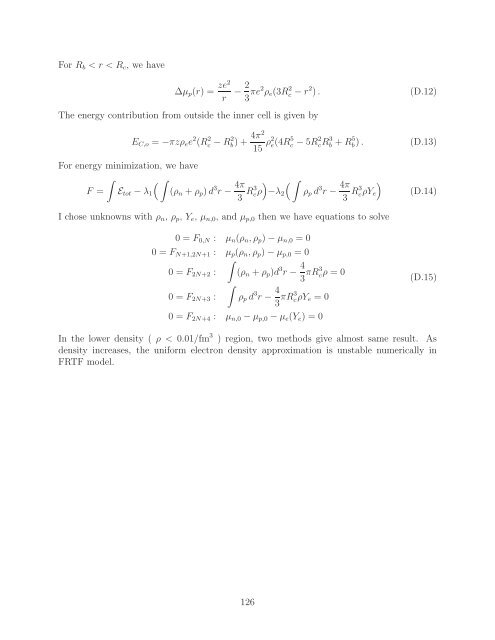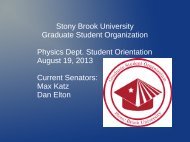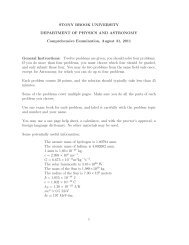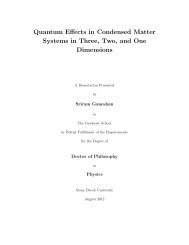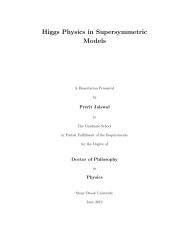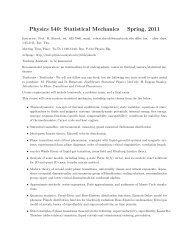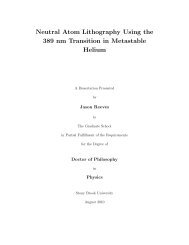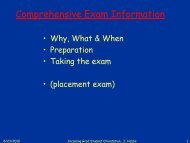- Page 1 and 2:
Theory of nuclear matter of neutron
- Page 3 and 4:
Abstract of the DissertationTheory
- Page 5 and 6:
To Jaenyeong, Jonghyun, and Jongbum
- Page 7 and 8:
3.3 Optimized Parameter Set . . . .
- Page 9 and 10:
List of Figures1.1 Mass and radius
- Page 11 and 12:
SymbolsNuclear Physics SymbolE ener
- Page 13 and 14:
ω δt 90−10QtT cTaylor expansion
- Page 15 and 16:
List of Tables1.1 Range of Tables .
- Page 17 and 18:
Chapter 1IntroductionStars give us
- Page 19 and 20:
Since the mass of neutron star is d
- Page 21 and 22:
shown in Fig. 1.2, LS220 is the onl
- Page 23 and 24:
density:p = ρ2ρ o[ K9µ n = −B
- Page 25 and 26:
nuclear energy density functional i
- Page 27 and 28:
2.3.2 Thermodynamic QuantitiesThe t
- Page 29 and 30:
point r and with momentum p isU n (
- Page 31 and 32:
Thus, in the case of zero temperatu
- Page 33 and 34:
For standard nuclear matter, u = 1
- Page 35 and 36:
a α L α U β L β U σ0.5882 1.11
- Page 37 and 38:
Figure 2.2: Bulk equilibrium of T =
- Page 39 and 40:
Figure 2.4: Coexistence curves for
- Page 41 and 42:
proton fraction x are irrelevant fo
- Page 43 and 44:
potential model analogue for the Ha
- Page 45 and 46:
with the convention that z II is th
- Page 47 and 48:
Figure 2.10: The surface tension of
- Page 49 and 50:
Figure 2.12: Contour plots of surfa
- Page 51 and 52:
2.6.2 Dense Matter and the Wigner-S
- Page 53 and 54:
Figure 2.15: Proton number per unit
- Page 55 and 56:
Chapter 3Modified model† The trun
- Page 57 and 58:
We choose the value ǫ = 1/3. One m
- Page 59 and 60:
where∆V t = T oρ o[( ρρ o) ǫ[
- Page 61 and 62:
Q 1 to a small number also results
- Page 63 and 64:
where p = (S v ,L) and M ij = 1 ∂
- Page 65 and 66:
3.4 Nuclear Surface TensionCompared
- Page 67 and 68:
1.41.2FRTF II ω 0 , T=0 MeVFRTF II
- Page 69 and 70:
For the finite-range term, we use a
- Page 71 and 72:
Landau’s quasi-particle formula g
- Page 73 and 74:
The symmetry energy in nuclear matt
- Page 75 and 76:
Figure 4.2: The left figure shows t
- Page 77 and 78:
Figure 4.4: This figure shows the b
- Page 79 and 80:
Figure 4.5: In a neutron star, heav
- Page 81 and 82:
The energy exchange from the gradie
- Page 83 and 84:
Figure 4.8: The left panel shows th
- Page 85 and 86:
4.5 Astrophysical application4.5.1
- Page 87 and 88:
0.550.5GaussianFRTF IIFRTF I0.450.4
- Page 89 and 90:
neutron matter respectively. Those
- Page 91 and 92: Table 5.3: Nuclear properties of si
- Page 93 and 94: which aref Rc = a 0 +a 1 x+a 2 x 2
- Page 95 and 96: parametrized[ht]504540EDF, Z nucFit
- Page 97 and 98: Chapter 6Nuclear Equation of State
- Page 99 and 100: Coulomb, and, symmetry part [24], i
- Page 101 and 102: We can eliminate N s , leading to t
- Page 103 and 104: pressure from pure neutron matter,
- Page 105 and 106: 2.52GSRsSGISIVSkaSkI1SkI2SkI3SkI5St
- Page 107 and 108: HNsn, p, α,eFigure 6.7: In the Wig
- Page 109 and 110: Table 6.1: Surface tension analytic
- Page 111 and 112: free energy density for the alpha p
- Page 113 and 114: Here s ′ = ∂s(u)/∂u.The minim
- Page 115 and 116: 6.5.2 Determination of Coulomb surf
- Page 117 and 118: gives analytic derivatives of therm
- Page 119 and 120: 200180160Atomic number, Y p =0.45,
- Page 121 and 122: for Fermi integral. This fitting fu
- Page 123 and 124: A.1 Taylor expansion integrationThe
- Page 125 and 126: thenwhere0u − i+1 = fu− i +J
- Page 127 and 128: We separate the two integrals as in
- Page 129 and 130: Each w i can be obtained[ae −∆/
- Page 131 and 132: By expanding e r 0/a −e −r 0/a
- Page 133 and 134: M 3 2a 0.433 1p 0 (e 2 /a) √ π/3
- Page 135 and 136: of find exact polynomial expression
- Page 137 and 138: Appendix CPhase coexistenceBulk equ
- Page 139 and 140: To summarize, we need to solve 5 eq
- Page 141: D.1 Non-uniform electron density ap
- Page 145 and 146: Table E.1: Non-relativistic Skyrme
- Page 147 and 148: [20] C.J. Pethick and D.G. Ravenhal


